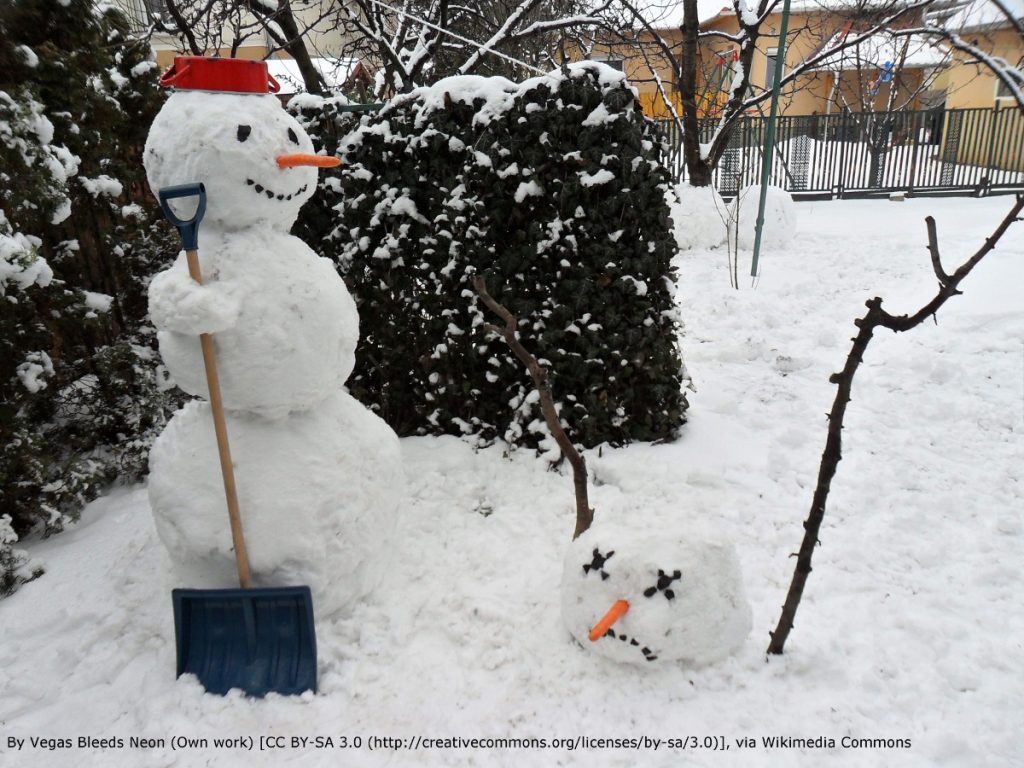 My dog’s got no nose. How does he smell? Awful. To prevent olfactory problems with snowmen the traditional nose of choice is the carrot. To most westerners, the carrot is a bright orange tapering root vegetable that can be eaten raw or cooked and that forms a vital part of Christmas lunch. To the allotment gardener, there might be a wider choice including purple, yellow and white colours and a range of shapes from long and tapering to stump rooted or globular. The first time I tried growing purple carrots I remember thinking I had planted the wrong variety, however as the roots matured they went purple from the outside in. At first the roots were orange and then a purple colour developed late in the season giving a period of time when the carrots produced wonderfully colourful bicoloured purple/orange slices. Eventually the fully purple and wonderfully nutty flavoured carrots resulted.
My dog’s got no nose. How does he smell? Awful. To prevent olfactory problems with snowmen the traditional nose of choice is the carrot. To most westerners, the carrot is a bright orange tapering root vegetable that can be eaten raw or cooked and that forms a vital part of Christmas lunch. To the allotment gardener, there might be a wider choice including purple, yellow and white colours and a range of shapes from long and tapering to stump rooted or globular. The first time I tried growing purple carrots I remember thinking I had planted the wrong variety, however as the roots matured they went purple from the outside in. At first the roots were orange and then a purple colour developed late in the season giving a period of time when the carrots produced wonderfully colourful bicoloured purple/orange slices. Eventually the fully purple and wonderfully nutty flavoured carrots resulted.
This root vegetable is a native of the Euro-Mediterranean region and extending far into temperate Asia. Its origin dates back over 2000 years but is confused by the similarity between wild carrot (Daucus carota L. subsp. carota) and the edible carrot (Daucus carota subsp. sativus) as well as other subspecies. This makes identification of archaeological material difficult. There is further confusion in historic illustrations where the parsnip and carrot are often not distinguishable.
Weird carrot facts
World’s heaviest carrot weighed 9.07 Kilos and was grown by Peter Glazebrook of Newark (UK) in 2014.
World’s longest carrot measured 6.245 m and was grown by Joe Atherton of Mansfield Woodhouse, Nottinghamshire (UK) in 2016.
World’s fastest marathon carrot was Edward Lumley (27) who ran a 26-mile course 2hrs 59 min 33 s in the 2010 London Marathon.
What is the ideal carrot for a snowman’s nose?
A pretty fundamental question which might be best answered by thorough analysis of fibre content, sugar content (important to stop carrots freezing in cold weather) and shape. Perhaps Autumn King offers a good combination of shape and hardiness? In reality the ideal snowman’s nose is whichever carrot happens to be lurking in the bottom of the salad drawer when you wake up to a surprise snowy morning.
The carrot genome
If you want to know the full intimate details of carrot genetics and the selection of genotypes in cultivation read the fascinating article in Nature genetics which tells a fascinating story of domestication and selection.
Further reading
On the history of carrots in cultivation the excellent 7-page article by John Stolarczyk and Jules Janick, Carrot: History and Iconography.
For just about every imaginable fact about carrot enthusiasm, try the World Carrot Museum, a virtual museum existing on the WWW.
References
Davidson, A. 1999. Oxford Companion to Food. Oxford Univ. Press, Oxford
Iorizzo, M., Ellison, S., Senalik, D., Zeng, P., Satapoomin, P., Huang, J., … Simon, P. (2016). A high-quality carrot genome assembly provides new insights into carotenoid accumulation and asterid genome evolution. Nature Genetics, 48(6), 657–666. https://doi.org/10.1038/ng.3565
Mackevic V.I. 1929. The carrot of Afghanistan. Bulletin of Applied Botany, Genetics and Plant Breeding 20: 517–562.
Stolarczyk, J. & Janick, J., 2011. Carrot: History and Iconography. Chronica Horticulturae, 51(2), pp.13–18. Available at: http://www.hort.purdue.edu/newcrop/pdfs/ch5102-carrot.pdf.




Pingback: Daughter of #adventbotany 2016 | Dr M Goes Wild
Pingback: #AdventBotany Christmas Day: A rose with no thorns; eyes without sight | Culham Research Group